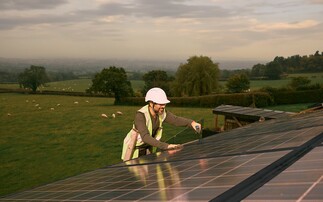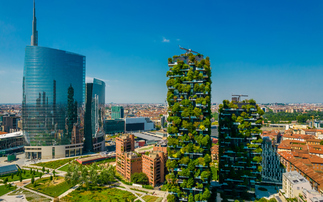
Credit: iStock
Experts from Equans, the UK Green Building Council, and Radisson Hotel Group explore how to build a credible business strategy for decarbonising the built environment
That energy costs have shot up over the last few years on the back of geopolitical and fossil fuel market volatility will not have been lost on UK businesses, many of which continue to grapple with rising overheads across their operations and supply chains.
For companies with significant physical assets and building footprints, high energy bills has become a frustratingly persistent challenge, prompting more and more businesses to explore green building solutions that promise to curb emissions and energy bills alike. The appeal is obvious, given such solutions can deliver multiple benefits: enhanced energy efficiency, lower emissions, new revenue streams, improved productivity, and reputational gains.
"There's just an absolute incentive there for building owners, occupiers and managers to really look at how buildings can be more energy efficient," said Yetunde Abdul, director of industry transformation at the UK Green Building Council (UKGBC). "That's the finance side of things, but it can also contribute to the achievement of net zero targets, or at least ensuring a building remains net zero-aligned."
Abdul was speaking during the first edition of BusinessGreen's new Spotlight series of monthly webinars, which brought together experts from across the built environment sector to explore how to curb energy costs for buildings. Hosted in association with low carbon energy and facilities services provider Equans, the hour long session saw Abdul joined by Joao Dias, global senior manager for net zero at Radisson Hotels, and Kevin Boniface, energy engineering manager at Equans. The panel offered a raft insights on how companies can identify the optimal mix of green building solutions to suit their needs and justify the capital investment required to roll them out.
Here are some of the key takeaways:
1. Be clear on a building's operations and energy use before planning upgrades
For older, poorly insulated buildings that remain reliant on fossil gas heating, it may seem obvious what the first steps should be towards a property that is healthier, greener, and cheaper to run: cleaner heating and better insulation.
But whether a building is hundreds of years old or brand-spanking new, without a proper energy audit existing problems and opportunities for savings are likely to be hard to spot, potentially leading to decisions on new technologies or retrofit measures that are not best suited to a building's specific needs or use patterns.
"It's about understanding those heating, ventilation, air conditioning, cooling systems, and what's the lifetime of them and how are they actually operating - spending some time in the building to understand what the improvements could be," said Boniface.
It is also important to delve into underlying energy use data to try and understand "where the biggest troughs might be, and how much energy is being used during the summer, when the heating should be off", he added. "You won't pick that up an any EPC [Energy Performance Certificate assessment] because they're in and out quite quickly - I think a dedicated specialist audit from an energy consultant would be the way to go forward initially."
2. There is no 'one-size-fits-all' green building solution
Boniface explained that while the energy crisis has driven growing numbers of firms to look at where they can make energy savings across their buildings, which has in turn led to "lots of low carbon retrofits", there are rarely any 'off-the-shelf' approaches available. Solar panels, energy storage, insulation, double and triple-glazing, heat pumps, air conditioning, energy management systems, district heating, LED lighting, and a lot more besides can all have a role to play.
"There are a lot of technologies and practices and philosophies out there that can be used," he said. "It can be confusing to people."
The size and geographic location of a building, what it is used for and by how many people, how old it is, what its present power and heating sources are, how efficiently they are used, and the capital investment and possible public funding available to fund any changes - these are just a handful of the considerations businesses need to factor in before plotting their building decarbonisation strategy.
3. Policy is a major driver behind building energy saving opportunities
When it comes to businesses deciding the pathway forward for greener buildings, national or local policy can be key drivers.
Rooftop solar panels have become particularly popular in recent years, in part driven by the government's Public Sector Decarbonisation Scheme, which helped a raft of NHS and school buildings to benefit from on-site renewable power generation. However, that scheme is now being phased out, with Great British Energy and the National Wealth Fund expected to play a bigger role in investing in public sector green building projects nationwide, including a new wave of solar and battery installations across the NHS and school estate.
Meanwhile, other schemes such as the Heat Network Efficiency Scheme, Industrial Energy Transformation Fund, various green hydrogen funding pots, and GB Energy's newly-launched Community Fund should also help to prime the market for green building energy solutions. Changes are also set to be made to tighten Minimum Energy Efficiency Standards (MEES) regulations for rented domestic and commercial properties, which could further drive up demand for green retrofits, while the new build sector will soon have to comply with the upcoming Future Homes Standard.
Any organisation considering a green building project is advised to take a close look at the various grants and tax breaks available, as well as the regulations they have to comply with.
4. The 'spark gap' remains a challenge
One of the best ways to cut emissions from a building is to switch from fossil fuels to a heat pump. But the heat pump roll out continues to be hampered by the fact such projects do not always result in cost savings. The panel warned that as long as electricity remains expensive relative to gas - the so-called 'spark gap' - the business case for heat pumps would continue to be undermined. As it stands, heat pump deployments tend to be reliant on either grant funding or a desire within the organisation to prioritise emissions reductions.
The government is looking at options for rebalancing energy bills, by potentially shifting some of the policy costs on electricity bills on to gas bills or general a taxation to boost the commercial case for electric heating, although no decisions have yet been made.
"Until the government actually gets a grip of that and sorts these things out - by changing levies across to gas from electricity perhaps - I think we're going to struggle to get fully down the road with heat pumps," said Boniface. "But there's other things that can be done in the meantime."
Abdul similarly pointed to housing policy and taxation as other areas that might drive the market for green building upgrades and heat pumps in the near future.
"There's so much that could happen through energy prices in terms of different incentives, but also through stamp duty as well," she said. "There may be other aspects as well that the government could choose to focus on."
Businesses would be wise to keep abreast of political and policy developments, it seems - not least the Chancellor's Budget announcements in November.
5. Be prepared for emergency maintenance and upgrade opportunities
With ageing buildings, gas boilers, and energy management systems, predicting breakdowns and problems can prove challenging, which means the opportunity to undertake green upgrades may not arrive at a convenient moment.
Best, then, to have a robust plan in place so that you are fully prepared to install the optimal green building solutions when either irresolvable breakdowns occur or replacement schedules allow. If not, you risk sinking investment into the easiest option available at the time, and potentially being lumbered with new but carbon intensive assets for the foreseeable future. Or, to put it another way: never go food shopping on an empty stomach - it only leads to poor decisions.
Such planning is an absolute necessity for Radisson Hotel Group, which is no stranger to frequent maintenance and upgrades across the hotels in its vast portfolio worldwide. When the firm decided to retrofit one of its Manchester hotels earlier this year, it was in part because the boilers needed changing anyway, enabling Dias and his colleagues to seize the opportunity to deliver Radisson's first verified net zero hotel.
"When that moment comes, you then have more of a lever to deploy a full decarbonisation plan because the hotel will allow me to, the moment is correct, and I'm able to provide a comparison of the costs of different equipment and efficiencies on offer," he explained.
6. Keep track of how buildings are being operated
High energy costs mean it is now possible to build a compelling business case for a wide range of energy efficiency upgrades and clean tech deployments. Ahead of undertaking a project, Equans can closely model future energy use and show how upgrades can deliver a return on investment.
But for those returns to be fully realised it is crucial that upgraded buildings are managed effectively and energy use from heating, cooling, and lighting is optimised. Thorough and accurate prior forecasts and assessments of the potential energy and cost savings on offer from green building upgrades are crucial for building the business case for action, but ultimately only real-world data can provide a true picture of how a building is utilised by staff day-to-day. The way a building is used can also evolve over time, and so management systems may need frequently tweaking to ensure a building continues to maximise the savings and benefits on offer.
For Equans this is a "massive, very real issue" when working with clients, according to Boniface.
"For clients, energy savings will pay for the cost of the measures over time, but the onus is on us as the provider to ensure that projected savings are being delivered," he explained. "If it's a 10-year contract, we do annual reporting and [if measures aren't delivering projected savings] then we have to pay the short fall. If it's a surplus and over-performing, then we get to share that with the client. That's how an energy performance contract works."
The good news is increasingly sophisticated energy management systems can automatically monitor and optimise energy use to tackle waste in real time. Dias explained how some Radisson hotels now operate energy management systems that are integrated with booking systems, so heating or cooling of rooms occurs just ahead of a guest arriving, resulting in significant savings.
7. Climate resilience considerations are critical
The vast majority buildings that will be used in a future UK net zero economy in 2050 already exist. That makes retrofitting critical to decarbonising the built environment, and it also means climate resilience considerations must be baked into refurbishment plans.
After all, many homes and commercial properties were built in a country that was used to experiencing 30C days on rare occasions. Now, 30C+ days are expected to become the norm during the summer months, while 40C days will become increasingly common, alongside more intense periods of both rainfall and drought throughout the year. That's even before considering risks such as coastal erosion, flooding, and wildfires.
"What, ultimately, is the need for the long term?" asked Abdul. "Taking a step back and having a general view of resilience is really important where possible."
As Boniface put it: "I'd be really worried if I saw a specification or brief from a client for any kind of building where it suggested a 'like for like' replacement. Because is something has been around for 20 years, it has been designed for a completely different set of environmental conditions to that which we have got now."
The financial benefit from enhanced climate resilience can be difficult to quantify, but like the enhanced health and productivity benefits that should come with greener buildings, they can significantly strengthen the business case for an organisation considering undertaking a building upgrade.
7. A range of funding options are available
Making the business case for green upgrades requires weighing up how much it costs to operate a building with the upfront costs of any new measures installed - aka OPEX versus CAPEX. Will these measures payback over time, and how quickly? Are there any co-benefits to consider, such as improved staff wellbeing, for example? Perhaps there are aforementioned policy changes or public funding options to also consider?
Increasingly, too, mortgage products that offer incentives for energy efficiency improvements are being developed, while some firms provide subscription options for some clean technologies that come with no upfront cost for the hardware itself. As ever, different options will suit different businesses and buildings.
"There's a lot out there, but I don't think there's any one answer to all of it," said Boniface. "Certainly, if you've got a big portfolio or estate - such as for a university - then you can start to talk to investors… But then that goes back to having a really detailed economic model, and being able to assure those investors that you've got an investable a rate of return on it."
For many businesses, buildings are the biggest part of their physical carbon and energy footprint. But with the right forward planning, technologies, and financial backing, buildings also hold huge opportunities for significant financial and environmental savings - and all while providing a tangible, physical exemplar of a company's net zero journey.
BusinessGreen's webinar in association with Equans - 'Spotlight on Buildings: How to slash energy costs' – can be watched back in full here.
BusinessGreen has further webinars coming up this autumn in our Spotlight series, covering topics such as skills, COP30, and carbon markets.









